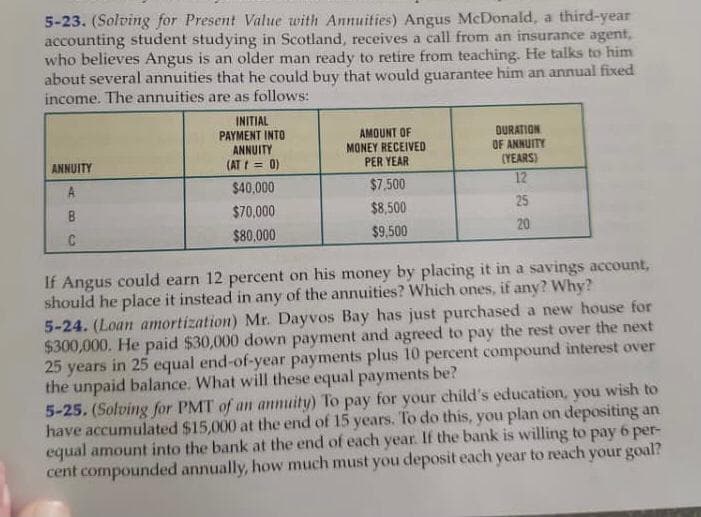5-23. (Solving for Present Value with Annuities) Angus McDonald, a third-year accounting student studying in Scotland, receives a call from an insurance agent, who believes Angus is an older man ready to retire from teaching. He talks to him about several annuities that he could buy that would guarantee him an annual fixed income. The annuities are as follows: INITIAL PAYMENT INTO ANNUITY (AT = 0) AMOUNT OF MONEY RECEIVED PER YEAR DURATION OF ANNUITY (YEARS) ANNUITY $40,000 $7.500 12 $70,000 $8,500 25 C $80,000 $9,500 20 If Angus could earn 12 percent on his money by placing it in a savings account, should he place it instead in any of the annuities? Which ones, if any? Why? 5-24. (Loan amortization) Mr. Dayvos Bay has just purchased a new house for $300,000. He paid $30,000 down payment and agreed to pay the rest over the next 25 in 25 equal end-of-year payments plus 10 percent compound interest over years the unpaid balance. What will these equal payments be? 5-25. (Solving for PMT of an annuity) To pay for your child's education, you wish to have accumulated $15,000 at the end of 15 years. To do this, you plan on depositing an equal amount into the bank at the end of each year. If the bank is willing to pay 6 per- cent compounded annually, how much must you deposit each year to reach your goal?
5-23. (Solving for Present Value with Annuities) Angus McDonald, a third-year accounting student studying in Scotland, receives a call from an insurance agent, who believes Angus is an older man ready to retire from teaching. He talks to him about several annuities that he could buy that would guarantee him an annual fixed income. The annuities are as follows: INITIAL PAYMENT INTO ANNUITY (AT = 0) AMOUNT OF MONEY RECEIVED PER YEAR DURATION OF ANNUITY (YEARS) ANNUITY $40,000 $7.500 12 $70,000 $8,500 25 C $80,000 $9,500 20 If Angus could earn 12 percent on his money by placing it in a savings account, should he place it instead in any of the annuities? Which ones, if any? Why? 5-24. (Loan amortization) Mr. Dayvos Bay has just purchased a new house for $300,000. He paid $30,000 down payment and agreed to pay the rest over the next 25 in 25 equal end-of-year payments plus 10 percent compound interest over years the unpaid balance. What will these equal payments be? 5-25. (Solving for PMT of an annuity) To pay for your child's education, you wish to have accumulated $15,000 at the end of 15 years. To do this, you plan on depositing an equal amount into the bank at the end of each year. If the bank is willing to pay 6 per- cent compounded annually, how much must you deposit each year to reach your goal?
Pfin (with Mindtap, 1 Term Printed Access Card) (mindtap Course List)
7th Edition
ISBN:9780357033609
Author:Randall Billingsley, Lawrence J. Gitman, Michael D. Joehnk
Publisher:Randall Billingsley, Lawrence J. Gitman, Michael D. Joehnk
Chapter14: Planning For Retirement
Section: Chapter Questions
Problem 8FPE
Related questions
Question

Transcribed Image Text:5-23. (Solving for Present Value with Annuities) Angus McDonald, a third-year
accounting student studying in Scotland, receives a call from an insurance agent,
who believes Angus is an older man ready to retire from teaching. He talks to him
about several annuities that he could buy that would guarantee him an annual fixed
income. The annuities are as follows:
INITIAL
PAYMENT INTO
ANNUITY
(AT I = 0)
DURATION
OF ANNUITY
(YEARS)
12
AMOUNT OF
MONEY RECEIVED
PER YEAR
ANNUITY
$40,000
$7.500
B
$70,000
$8,500
25
C
$80,000
$9,500
20
If Angus could earn 12 percent on his money by placing it in a savings account,
should he place it instead in any of the annuities? Which ones, if any? Why?
5-24. (Loan amortization) Mr. Dayvos Bay has just purchased a new house for
$300,000, He paid $30,000 down payment and agreed to pay the rest over the next
25 years in 25 equal end-of-year payments plus 10 percent compound interest over
the unpaid balance. What will these equal payments be?
5-25. (Solving for PMT of an annuity) To pay for your child's education, you wish to
have accumulated $15,000 at the end of 15 years. To do this, you plan on depositing an
equal amount into the bank at the end of each year. If the bank is willing to pay 6 per-
cent compounded annually, how much must you deposit each year to reach your goal?
Expert Solution
This question has been solved!
Explore an expertly crafted, step-by-step solution for a thorough understanding of key concepts.
This is a popular solution!
Trending now
This is a popular solution!
Step by step
Solved in 6 steps

Knowledge Booster
Learn more about
Need a deep-dive on the concept behind this application? Look no further. Learn more about this topic, finance and related others by exploring similar questions and additional content below.Recommended textbooks for you

Pfin (with Mindtap, 1 Term Printed Access Card) (…
Finance
ISBN:
9780357033609
Author:
Randall Billingsley, Lawrence J. Gitman, Michael D. Joehnk
Publisher:
Cengage Learning

Financial Accounting: The Impact on Decision Make…
Accounting
ISBN:
9781305654174
Author:
Gary A. Porter, Curtis L. Norton
Publisher:
Cengage Learning


Pfin (with Mindtap, 1 Term Printed Access Card) (…
Finance
ISBN:
9780357033609
Author:
Randall Billingsley, Lawrence J. Gitman, Michael D. Joehnk
Publisher:
Cengage Learning

Financial Accounting: The Impact on Decision Make…
Accounting
ISBN:
9781305654174
Author:
Gary A. Porter, Curtis L. Norton
Publisher:
Cengage Learning



Cornerstones of Cost Management (Cornerstones Ser…
Accounting
ISBN:
9781305970663
Author:
Don R. Hansen, Maryanne M. Mowen
Publisher:
Cengage Learning